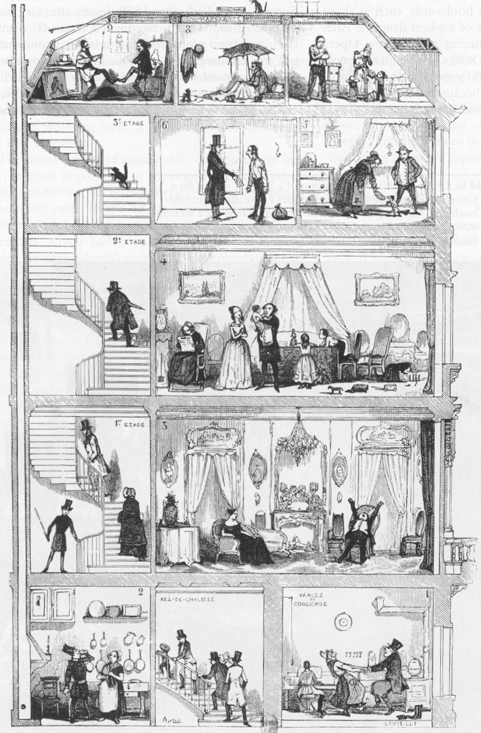Urbanization and Social Structure (circa 1850-1900)

Parisian Apartment Living (c. 1850)
Rising Standards of Living and Decreasing Mortality
Rising Real Wages
Public Health Movement
The Bacterial Revolution
Urban Planning
Transforming Paris: Napoleon III (r. 1848-70)- Georges Haussmann (1809-1884)
- razed buildings, demolished slums
- straight boulevards, rows of trees
- parks, open spaces, improved sewers
- better housing for middle classes
- Parisian model imitated (1870s+)
- Vienna, Cologne
- better housing, streets, water supply
- zoning laws for major street or sanitation work
Transforming Public Transportation - (1870s) horse-drawn streetcars
- (1890s) electric streetcars
- cheaper, faster, cleaner
- more comfortable & dependable
- helps improve housing---> expansion of cities
- less congestion
- new housing developments in outlying areas
Nineteenth-Century Social Hierarchy
Aristocracy- land-owning, agricultural-based wealth
Middle Classes - upper
- successful in banking, industry, commerce
- middle
- moderately successful
- traditional professions
- emerging professions
- engineers, architects, chemists
- surveyors, accountants
- public and private managerial
- civil servants, govt. officials
- railroad managers
- lower
- independent shopkeepers, small traders
- expanding white-collar jobs
- traveling salesmen, bookkeepers, store managers, clerks
- emerging professions
- nurses, elementary school teachers
Working Classes - highly-skilled, "labor aristocracy"
- construction bosses, factory foremen
- artisans and craftsmen
- printers, cabinet makers
- engravers, jewelers, potters, bookbinders
- watchmakers, woodcarvers
- flux in highly-skilled labor elite
- shipbuilders, machine toolmakers
- railway locomotive engineers, fine cotton textile spinners, metalworkers
- semi-skilled and unskilled
- carpenters, bricklayers, pipe fitters
- day laborers--> longshoremen, teamsters
- street vendors, market people
- domestic servants, stable boys
The town. . . is only inhabited by shopkeepers and operatives; the merchants and manufacturers have detached villas situated in the midst of gardens and parks in the country.
(commentator on Manchester, 1844)
Between the artisan and the unskilled labourer a gulf is fixed. While the former resents the spirit in which he believes the followers of genteel occupations look down upon him, he in turn looks down upon the labourer. The artisan creed with regard to the labourer is, that they are an inferior class, and that they should be made to know, and kept in their place.
(a working-class author, 1873)
These stores have increased in number and several of them have become extremely large. Combining in their different departments all articles of clothing, toilet articles, furniture and many other ranges of goods, it is their special object so to combine all commodities as to attract and satisfy customers. . . The success of these department stores is only possible thanks to the volume of their business. . . The large urban agglomerations, the ease with which goods can be transported by the railways, the diffusion of some comforts to strata below the middle classes, have all favoured these developments.
(French description of department stores, 1907)

